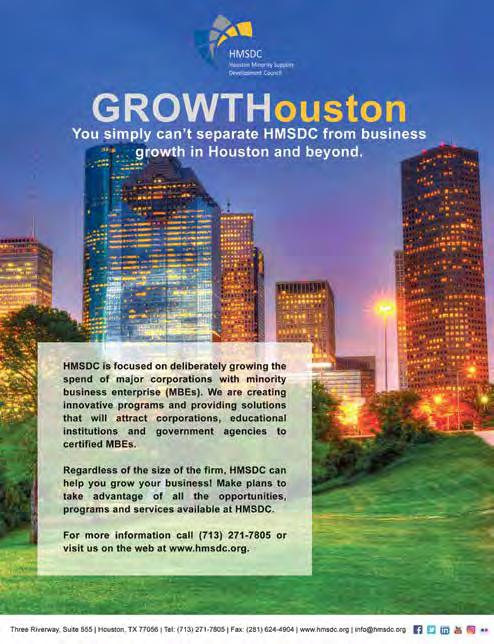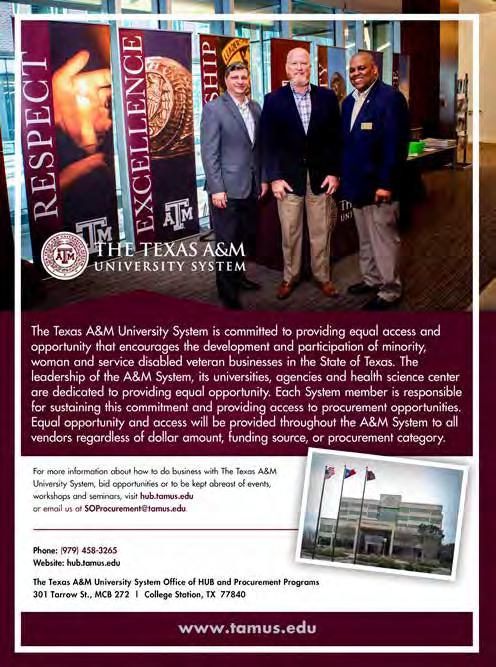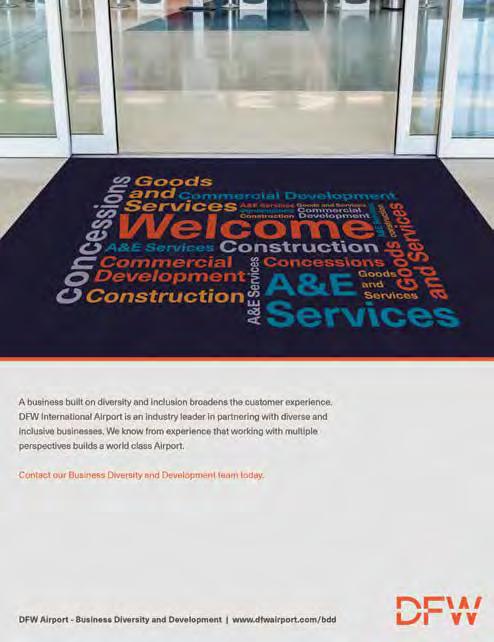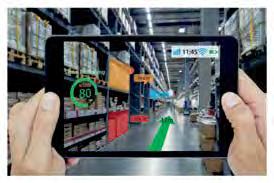
14 minute read
CONSTRUCTION
CONSTRUCTION CONTRACTORS PLEDGE to combat racial inequality
By Subcontractors USA News Provider
Construction firms across the country are responding to recent protests against police brutality and racial injustice with statements calling for an end to inequity and with programs to attract and retain diverse team members.
Turner Construction has posted messages of support on its websites and on social media. "Recent events are a stark and painful reminder of the consequences of ongoing, undeniable racism that exists in our communities," wrote Turner CEO Peter Davoren.
Daniel L. Johnson, CEO, and David C. Mortenson, chairman, of Minneapolis-based Mortenson, signed a statement from 29 Minnesota-based companies calling for an end to racial inequities that led to the May 25 killing of George Floyd by a Minneapolis police officer.
“These acts are painful and traumatic for our entire community, especially our communities of color,” they wrote. “The repeated occurrence of racially charged events of this nature are contrary to the close-knit employment and residential communities we desire to have in Minnesota.”
One hundred and eleven companies so far have joined the Associated General Contractors' newly formed Culture of CARE program designed to help contractors create more welcoming workplace environments for staff, particularly those from diverse demographic backgrounds. These companies — including Hensel Phelps, PCL and Skanska — have taken a pledge to ensure their workplaces are free from harassment, hazing and bullying.
As part of the program, the AGC is offering training designed to establish more inclusive workplaces. There are also broader educational materials available from the Culture of CARE program, including sample HR policies, toolbox talks, jobsite posters and hardhat stickers.
Talking points Talking points
The George Floyd murder and subsequent public outcry has renewed the conversation around race in the construction industry, according to Brynn Huneke, AGC director of diversity and inclusion. "While there are lots of companies in the construction industry that have diversity and inclusion efforts and have had them for a long time, I think this has reignited their desire to continue to grow and push and examine their own cultures and policies and practices and look at them through a diversity and inclusion lens," she said.
The numbers show there is still much work to be done in order to diversify the industry. For instance, African-American workers represent 12% of the total U.S. workforce but only 6% of the construction workforce, AGC Vice President of Public Affairs and Strategic Initiatives Brian Turmail said, and women are more than half of the U.S. workforce but make up only 3% of craft construction workers and 9% of the total construction workforce.
To help raise those numbers, the Associated General Contractors of San Diego announced last week that it has signed a memorandum of agreement with the Black Contractors Association of San Diego to expand and strengthen training programs for African Americans and other underrepresented groups in the city.
The organization’s aim is to build a regional construction workforce that is representative of San Diego’s diverse community, said Bill Haithcock, president of AGC San Diego, in a statement announcing the partnership.
Abdur-Rahim Hameed, president of the Black Contractors Association, said that the agreement is a “huge step in the right direction” and will more than double the number of apprenticeship positions, such as carpenters and drywallers, at local jobsites.
Staff support Staff support
While standing against racial equality is the right thing to do, it also makes good business sense, Turmail told Construction Dive. Corporations as varied as Coca-Cola, Target, TD Bank and the NFL have all taken a stand with protestors responding to Floyd's killing.
Construction companies are often asked about their inclusiveness during major construction projects or on state or federal jobs and recent incidents will increase this awareness by owners, he said.
“Companies want to make sure they are doing business with firms that are inclusive and doing their best to make sure they reflect the culture of the communities where they operate,” he said.
A recent AGC white paper highlights that an emphasis on diversity and inclusion can positively impact company profitability by improving employee productivity, recruiting and retaining top talent, increasing innovation and creating a safer workplace. Furthermore, collaborative partnerships with diverse entities provide opportunities to expand market share. It’s also important for organization leaders to acknowledge how employees are affected by the issue, according to J. Christopher Hamilton, an attorney and assistant professor at the S.I. Newhouse School of Public Communications at Syracuse University. As many organizations are operating in a telework environment amid the COVID-19 pandemic, a companywide virtual town hall is the best method for a CEO to "express that they stand on the side of justice," Hamilton told HR Dive, our sister publication. The meeting will create the right atmosphere and supportive environment, providing a conduit to express concerns, he said.
Leaders should affirm that they "stand behind the organization's antidiscrimination policies, and will continue to operate in accordance with U.S. Equal Employment Opportunity Commission [EEOC] guidelines and regulations," he said.
Surveys can be helpful for identifying potentially disruptive issues within an organization. This method provides an opportunity for organizations that are trying to be "progressive, thoughtful and effective in their management," as well as those trying to create "an environment of inclusivity within the organization," Hamilton said.
Research shows that employers can boost retention by showing employees empathy. "If you don't acknowledge the emotional and psychological impact on your staff during a national crisis," Hamilton said, "then you will not be prepared to address the implications that has for your bottom line."

Department of Commerce Announces New National Director of Minority Business Development Agency


By Subcontractors USA News Provider

Today, U.S. Secretary of Com- merce Wilbur Ross announced that David J. Byrd will be the new National Director of the U.S. De- partment of Commerce’s Minority Busi- ness Development Agency (MBDA). Mr. Byrd will be the 18th National Di- rector of the agency.
Established by an Executive Order in 1969, MBDA is the only Federal agency solely dedicated to the growth and global competitive- ness of U.S. minorityowned businesses.
“D av id ’s vast experi- ence in pub- lic service and as an en- trepreneur are true assets to MBDA and the Department of Commerce,” said Secretary Ross. “In his new role, I fully expect him to continue to provide the type of leadership that will lay the foun- dation to usher in the next 50 years of opportunities and growth for minorities as well as the country as a whole.”
Mr. Byrd joined MBDA in October 2019 as the National Deputy Director responsible for overseeing the day-to-day departmental operations and establish- ing a streamlined information portal to track Agency milestones and program execution. As MBDA National Director,

Mr. Byrd will oversee the development and implementation of Agency initia- tives, policy agenda, and federal grant programs.
“I am honored to be selected by Secre- tary Ross to lead the Minority Business Development Agency”, said Mr. Byrd. “I am proud to take the helm as the Na- tional Director following several of my career mentors who were instrumental in shaping the mission and strategic direction of MBDA since its founding in 1969. I look forward to continuing the Agency’s work ensuring the resil- iency and growth of America’s minorityowned firms today, tomorrow, and for future gen- erations of m inority entrepreneurs.” Prior to ac- cepting the fourth presi- dential ap- pointment of his career at MBDA, Mr. Byrd served as the Deputy Assistant Secretary, Office of Policy De- velopment, at the U.S. Department of Housing and Urban Development. His more than 28-year career in public service has included executive positions at the county, state, and federal levels. Mr. Byrd is also an experienced entrepreneur who owned and operated a consulting firm specializing in government rela- tions, political consulting, executive and life skills coaching.

Call Today 713-373.5577

CONSTRUCTION Passage Of Paycheck Protection Program Improvements Will Save Many Construction Jobs And Protect Construction Employers
By Subcontractors USA News Provider
With Needed Improvements to the Vital Survival Program Complete, Construction Official Urges Congress and the President to Act Quickly on Measures to Rebuild the Economy and Restore Jobs
The chief executive officer of the Associated General Contractors of America, Stephen E. Sandherr, issued the following statement in reaction to the passage of the Paycheck Protection Program Flexibility Act of 2020:
“This new law improves upon the original Paycheck Protection Program by extending the coverage period to 24 weeks, revising the ratio of percentage of expenses allowed to be forgiven up to 60 percent payroll costs and 40 percent non-payroll, extending the maturity period for the loans from two years to five, and allowing loan recipients to defer payroll taxes through the end of 2020. Its enactment will save many construction jobs and allow thousands of construction firms to remain in business.
“Having fixed several problems with a measure designed to helped firms survive, it is time for Congress and the President to put in place measures to rebuild our economy. These measures include providing liability protection for contractors and other businesses that are taking steps to protect workers from the coronavirus, new infrastructure funding and measures to stimulate broader, private-sector demand for construction and development.”

Source: Associated General Contractors




IT & TECHNOLOGY 5 BEST TECH The Opportunities for Construction Companies
By Subcontractors USA News Provider
Construction has been one of the slowest industries to adopt technology. That’s partly cultural—folks in the industry like to solve problems with their own ingenuity. Many firms are still family owned, and there’s still a lot reverence for tradition. Plus, this is an industry with thin margins, where the first funding priorities are equipment and personnel.
But, it’s also partly because there hasn’t been a lot of technology built to meet the needs of the industry. Before smart phones, it was hard to bring technology to the field. Even then, you had to have a good Wi-Fi connection, which wasn’t consistently available, or an expensive data plan. And, a lot of early field capture technology was based on someone having to manually input data into a device. That was a non-starter; having superintendents manually entering data didn’t really provide much in the way of productivity gains, and made for a lot of unhappy superintendents.
Now all that is changing. Founders are aging out of the industry, creating an opportunity for younger generations to apply technology with less resistance. Project owners are requiring the use of different technologies as a condition of funding. And, there are an increasing number of great solutions specifically designed for the industry. Connectivity and computing power have increased dramatically, making mobile applications a lot more reliable, robust and user-friendly. Cameras, drones, GPS, and RFID technology are making it easy to capture data without human intervention.
As more technology comes into play, the industry is finally waking up to the impact it can have on bottom line profitability. Here are some of the technology opportunities construction companies should have on their radar: 1. AR and VR 1 AR and VR
Whether it’s on a computer screen or through a headset, augmented and virtual reality are taking the output of BIM software and creating virtual models of a structure subcontractors can walk through before it’s even built, allowing them to collaborate and spot potential issues in a virtual environment.
For example, an electrical contractor could walk through the schematic of what the mechanical contractor would have built so they can say, “Okay, I see that there’s going to be a standpipe here, so we’ll run our conduit right next to it.” That leads to less rework and fewer scheduling delays. AR can also be used to help train workers in a more effective and cost-efficient manner. 2. AI: NOT YET 2 AI: NOT YET
Artificial intelligence could potentially have a big impact on the industry, but probably not for quite a few years. One immediate application is jobsite safety. There are already rudimentary tools that can analyze video from jobsite

cameras and spot hazards. They can also determine from workers’ movements whether or not they’re accessing a scaffold or carrying materials up a flight of stairs correctly.
Eventually AI could be used to help improve project scheduling by learning from data from past projects and flagging issues that could lead to delays. It could analyze the performance of buildings over time and offer materials recommendations. But AI needs relevant data to learn from, so the industry needs to digitize first. 3. INTERNET OF THINGS 3 INTERNET OF THINGS
If you look at industries that are starting to see some success with AI, such as health care and manufacturing, everything is happening more or less in one place. That makes it easier to put sensors on a machine or robot and capture data. It’s a bit more of a challenge when you have multiple jobsites and a lot of movable equipment, so taking data capture out of the hands of individuals and automating it, and storing data in a centralized place where it can be managed is the frontier right now. 4. BACK OFFICE EFFICIENCY 4 BACK OFFICE EFFICIENCY
Most firms are using some sort of automated accounting platform. But there are still gaps that need to be filled.
Invoice routing and approval is a big one. People are literally having the back office scan invoices and then email out invoice images to the project superintendent. Invoice images are “digital paper,” meaning they’re not actual digital artifacts. Any data that’s on them has to be manually entered, and the whole routing and approval process is manual as well.
Then there’s the payment process itself. Solutions built to handle procure to pay actually only handle procure to invoice approval, so then you need a payments automation solution on top of that. The good news is that automating payments is pretty easy to do, and it doesn’t depend on automating the invoice workflow, which is a much bigger project. 5. BUSINESS BUSINESS 5 INTELLIGENCE INTELLIGENCE Most ERP systems offer tons of reports, but people want to combine that with data from other sources. They want to be able to look at the d ata three-dimensionally and be able to drill into it. ERP systems don’t have that kind of capability, and as the amount of data companies have access to grows, so does the need to have a business intelligence platform to pull it together and generate analyses and models.
There are a lot of challenges to overcome before construction becomes a fully digitized industry. It’s still hard to deploy technology organization-wide when you have workers on multiple job sites. Do you pull everyone off the job to come in for training? Probably not. Adoption can move pretty slowly, with some workers using the technology and others continuing to do things the way they’ve always done them. That creates data silos that require manual intervention to boil up to actionable, executive level reporting. So, it may take longer to realize the ROI on some tech investments than in other industries. Nonetheless, the industry is moving forward.
Fifteen years ago, you had cutting-edge technology vendors trying to convince construction companies to test their new tablet-based reporting tool or time card, but the use cases weren’t compelling. Now that there are a lot of proven solutions from reputable vendors, there’s more trust and confidence that field solutions are going to be dependable and effective.
Contractors are starting to realize that if they want to win bids, they have to bring that to the table. You have people in the field who are now used to doing everything on their mobile phones. And you have this generational shift happening, with younger generations expecting to apply technology to any number of use cases. It’s a magical moment in time where the industry is poised to leap into the future.








